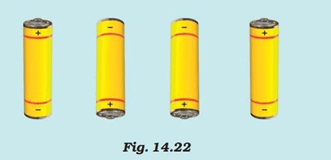NCERT Solutions Class 7 Science Chapter 10 Electric Current and Its Effects are provided here to help students in understanding the topic thoroughly. All these solutions are solved by experts with a detailed explanation. Class 7 NCERT Solutions for Science Chapter 10 includes all the textbook exercise questions and answers. These solutions will help students complete their assignments & homework.
Class 7 Science Electric Current and Its Effects Questions and Answers
Exercise Questions
Question 1: Draw in your notebook the symbols to represent the following components of electrical circuits: connecting wires, switch in the ‘OFF’ position, bulb, cell, switch in the ‘ON’ position, and battery

Answer:
Question 2: Draw the circuit diagram to represent the circuit shown in Fig.14.21.

Answer:

Question 3: Fig.14.22 shows four cells fixed on a board. Draw lines to indicate how you will connect their terminals with wires to make a battery of four cells.

Answer: To make a battery of cells, the positive terminal (+) of one cell always be connected to negative terminal (-) of another cell.

Question 4: The bulb in the circuit shown in Fig.14.23 does not glow. Can you identify the problem? Make necessary changes in the circuit to make the bulb glow.

Answer: The positive terminal (+) of one cell always be connected to the negative terminal (-) of another cell. Here the two positive terminals are connected to each other. The correct arrangement is as follows:

Question 5: Name any two effects of electric current.
Answer: The two effects of electric current are
(i) Heating effect of electric current
(ii) Magnetic effect of electric current
Question 6: When the current is switched on through a wire, a compass needle kept nearby gets deflected from its north-south position. Explain.
Answer: The current-carrying wire produces a magnetic field around it. When a compass is kept nearby this wire, the two magnetic field (magnetic field due to wire and magnetic field due to compass) interact with each other causing deflection in the magnetic needle. When the current is switched off, there is no magnetic field produced by the wire, the magnetic needle does not deflect from its north-south position.
Question 7: Will the compass needle show deflection when the switch in the circuit shown by Fig.14.24 is closed?

Answer: No. The given circuit does not have any current source. In the absence of current, the wire does not behave as a magnet and hence, the compass needle will not show any deflection.
Question 8: Fill in the blanks:
(a) Longer line in the symbol for a cell represents its ___________terminal
(b) The combination of two or more cells is called a ____________.
(c) When current is switched ‘on’ in a room heater, it ___________.
(d) The safety device based on the heating effect of electric current is called a _____________.
Ans.(a) positive
(b) battery
(c) produces heat
(d) fuse.
Question 9: Mark ‘T’ if the statement is true and ‘F’ it is a false:
(a) To make a battery of two cells, the negative terminal of one cell is connected to the negative terminal of the other cell. [T/F]
(b) When the electric current through the fuse exceeds a certain limit, the fuse wire melts and breaks. [T/F]
(c) An electromagnet does not attract a piece of iron. [T/F]
(d) An electric bell has an electromagnet. [T/F]
Answer: (a) False
(b) True
(c) False
(d) True
Question 10: Do you think an electromagnet can be used for separating plastic bags from a garbage heap? Explain.
Answer: No, electromagnets can only attract magnetic materials. Plastic bag is a non-magnetic material and will not be attracted by an electromagnet. Hence, an electromagnet cannot be used for separating plastic bags from a garbage heap.
Question 11: An electrician is carrying out some repairs in your house. He wants to replace a fuse by a piece of wire. Would you agree? Give reasons for your response.
Answer: It is not a wise idea to replace fuse by a piece of wire, as it has very low melting point. In case of metal piece, melting point will be high and the circuit will be intact in case there is overload or overheat.
Question 12: Zubeda made an electric circuit using a cell holder, a switch and a bulb. When she put the switch in the ‘ON’ position, the bulb did not glow. Help Zubeda in identifying the possible defects in the circuit.
Answer 12: Possible reasons are as follows:
- The bulb may be fused or defective.
- Cells are not connected properly.
- There may be loose connections.
- The switch is not functioning well.
- The cells are dried up i.e. the power of the cell has been exhausted.
Question 13: In the circuit shown in Fig. 14.25

(i) Would any of the bulb glow when the switch is in the ‘OFF’ position?
(ii) What will be the order in which the bulbs A, B and C will glow when the switch is moved to the ‘ON’ position?
Answer: (i) None of the bulb will glow when the switch is in the OFF position, since the electric circuit is not closed.
(ii) When the switch is moved to ‘ON’ position, circuit is complete and electric current will flow immediately. All of the bulbs will glow instantly.
Having a good grasp over CBSE NCERT Solutions for Class 7 Science will further help the students in their preparation for board exams and other competitive exams. NCERT Solutions for Class 7 Science Chapter 10 Electric Current and Its Effects provided by CBSE Path help students to clear their doubts and to obtain good marks in the exams. All the solutions provided in this article are strictly based on the CBSE syllabus and curriculum.